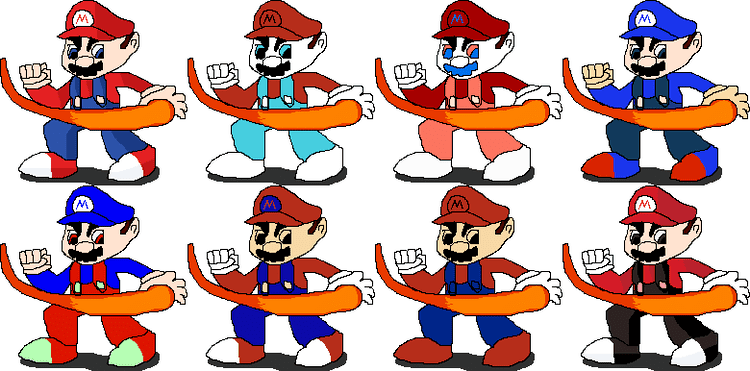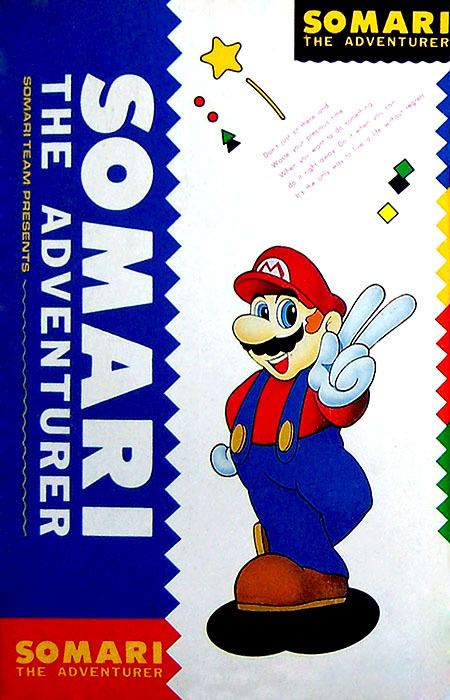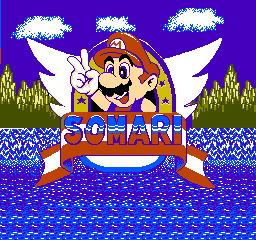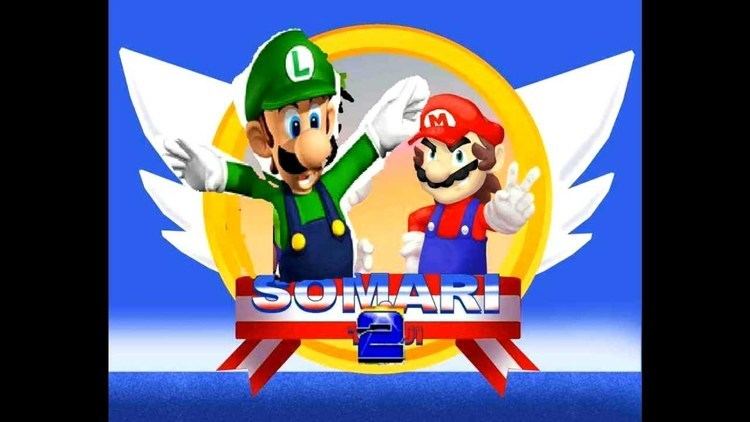Publisher(s) Ge De Industry Co. | Initial release date 1994 | |
 | ||
Developer(s) Hummer Team (as Somari Team) Similar | ||
Obscure gaming somari bootleg nes
Somari (Russian: Сомари; also known as Somari the Adventurer) is an unlicensed port of Sega's flagship video game Sonic the Hedgehog, produced for the Nintendo Famicom and sold primarily around Asia, Russia, and other regions where pirate Famicom cartridges were distributed, in 1994. The game features a character named "Somari" – Nintendo's mascot Mario wearing Miles "Tails" Prower's shoes. The character's name is a portmanteau of "Sonic" and "Mario".
Contents

Plot

The plot of Somari borrows heavily from that of the first Sonic title. Somari the Adventurer, an Italian plumber with distinct visual similarities to Mario, has become lost in his plumbing pipes and has emerged in Sonic's world. While wandering through the landscape Somari encounters numerous roboticized animals that begin to attack him. These robotic animals, the creations of the mad Dr. Robotnik, are part of a scheme plan to convert all animals into evil robots. Attempting to put an end to these transformations, Somari progresses through six zones - each comprising three acts - to finally defeat Dr. Robotnik. Along the way Somari must defeat legions of evil robot animals and must tangle with Dr. Robotnik himself five times. After Dr. Robotnik is defeated, Somari frees the helpless animals. During the ending, Dr. Robotnik can be seen juggling the 6 Chaos Emeralds stating "I will be back."
Gameplay

The gameplay of Somari is substantially similar to that of its predecessor, Sonic the Hedgehog. Mirroring Sonic's emphasis on speed, Somari runs nearly as fast as Sonic although it is sometimes difficult to get Somari to accelerate and the gameplay as a whole is slightly slower. Items, bosses, levels, and enemies are all identical to Sonic. Somari must collect 100 golden rings in order to enter the bonus stage at the end of the level, but being injured by enemies causes him to lose rings. Special stages do not serve any purpose apart from boosting the player's score. The game employs a timer as in Sonic, however regardless of what time is scored the player always gets a "Time Bonus" of 5000 points. As in "Sonic," each level is divided into three levels (referred to as "acts"), and the third level ends with a boss fight with Robotnik.
Although Somari borrows the concepts for its game dynamics from the original Sonic the Hedgehog, the implementation of them differs in many significant ways. Unlike the original Sonic the Hedgehog game, Somari can use the "spin-dash" feature first implemented in Sonic the Hedgehog 2. Other notable differences include the fact that whereas Sonic would lose all his collected rings after being injured by an enemy, Somari always loses a maximum of 3 rings even when carrying a single ring. Each area in Somari is taken from the original Sonic the Hedgehog game, borrowing many elements from the original stages, but some level layouts are completely new. Significantly, elements of level design from the Mario series such as off-screen secret areas high above the player's field of view make appearances in certain areas.
Development
Somari's levels are based on the Mega Drive/Genesis version of the first Sonic game, with the exception of the Scrap Brain Zone (of which a semi-functional version is accessible if save state hacking is used), while the bonus stages are based on the Master System and Game Gear versions. The game features Sonic's Spin Dash, which was not actually introduced until Sonic the Hedgehog 2. The music of the game is similar to the original, but suffers from a poor conversion to the Family Computer's sound system. The actual sprite for Somari is based on Mario's sprites from Super Mario Bros. 3.
It is unknown precisely how, when, or where the game was created, though Asia is likely, and Taiwan probable as a Taiwanese trademark for "Somari" was registered on March 1, 1994 following the earlier registry of the trademark "Sonimari" on February 1 of the same year. Some cartridges bear the copyright notice "1994 Someri Team". What few other hints exist of the game's origin can only be traced through the game itself: Though its basic structure is an imperfect transfer of the original Sonic the Hedgehog game, the movement of Somari is based on the mechanics and physics of the Sonic character from the 1992 release Sonic the Hedgehog 2. The title screen is based on the title screen from the original Sonic the Hedgehog game. The oldest PCB is dated January 1994.
The game was marketed in gaming magazines in Hong Kong and in Russia during the late 1990s, and it can be found today in the United States in specialized gaming stores.
Reception
The concept of a crossover or mashup title bringing the popular video game characters Mario and Sonic the Hedgehog into one game has been a long-running dream in video game culture. Although Somari does not feature both characters in the same game, the fact that Mario had been placed into the world of Sonic the Hedgehog was registered with astonishment. Russian gaming magazine Great Drakon scored the game 4/10 (only 2/10 for sales volume) and commented in a review that at last 8-bit console gamers could roughly gain the experience of 16-bit gaming as with Sonic.
Despite the obvious similarities of the game to Sonic the Hedgehog, reviewers were quick to point out the many differences between them and commentators on Russian TV program, Dendy: The New Reality (Russian: Денди новая реальность, tr. Dendy Novaya Realnost; IPA: [ˈdʲenʲdʲɪ ˈnovəjə rʲɪˈalʲnəsʲtʲ]), stated that "Somari for Dendy is not the same as Sonic for SEGA. ... Everything's different." Contemporary criticism of the game emphasized its difficulty relative to the original Sonic title (specifically the fact that the player would frequently and repeatedly die) and the game was characterized as having complex controls (although reviews claimed that these could be mastered in time).
GamesRadar listed Somari on their list of "Crazy ass rom hacks", calling it "Less mash-up and more train wreck" due to poor physics and unresponsive controls. GameSpy, however, described the game as "a remarkably good port/hack of Sonic to the NES," and Atari HQ described it as "amazing[ly] original" with "more than adequate[]" level-porting.
